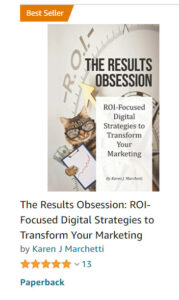“On the TWELFTH Day of Planning, (and full of holiday spirit!) your boss will ask of you: 12 Analytics to Track . . .
ELEVEN Copy Review Points . . . TEN Content Marketing Questions . . . NINE Lead Generation Strategies . . . EIGHT Google Ads Success Secrets . . . SEVEN Email Guidelines . . . SIX Website Improvements . . . FIVE Lead Capture Strategies . . . FOUR SEO Factors . . . THREE Design Directives . . . TWO Website Questions . . . and ONE Measurable Marketing Plan . . .”
We want conversions, positive growth, AND engagement. Here are the top track-able marketing analytics we’re paying attention to now . . .
1. Number of Unique Visitors to Your Website
Each month, review your website analytics and compute the number of conversions divided by unique visitors. You want to see consistent website traffic, a steadily improving (or a good) conversion percentage, and a steady stream of conversions that is meeting your lead generation or sales goals
2. First Time Visitors to the Website
If you’re trying to generate leads or grow your customer base, you need a constant stream of first-time visitors. Track the number of first-time visitors to your website each month. You should see that number steadily improving, as you build new content and run new traffic-driving campaigns.
3. Traffic Sources Referring Prospects to the Website
If you’re creating blog posts and optimizing each one for search engines, and posting on social media sites, you should expect to see strong traffic from those efforts. Track your Organic traffic each month, as well as traffic from your social media sites. Not all sites are equally as effective at driving traffic. So don’t keep posting aimlessly on every site if you’re not seeing traffic from each one.
4. Keywords Driving Traffic to the Website
Every SEO pro pays attention to the Keywords that actually drove traffic to the website during the month. As you continue to create new Content, you should see more “non-branded” keywords driving traffic (“non-branded” keywords don’t contain your company or product names). If you continue to see few non-branded keywords driving traffic (see Google Search Console and other tools), your SEO may need improvement or you may need to create more Content.
5. Growth in Prospect Database
A growing prospect database gives us an audience to communicate with on a regular basis and share recent blog posts, special Offers, and educational emails that illustrate our thinking and prove our expertise. Look at traffic to each of your Lead Generation Offer pages and the Conversion Rate for each page. If traffic is low, make your Offer more visible on Home, Product pages, and blog posts. If Conversion is low, re-name or redesign your Offer, make your “what you’re going to learn” bullet points sound more valuable, or reduce the number of fields you’re including on your response form.
6. Conversion Rate (to Leads or Sales)
Track your Conversion Rate overall for your website, by Offer page, and by each e-commerce product page. Consider testing new Offers, a new name for an Offer, new promotional copy, or fewer fields in your response form. Try to improve ecommerce conversion by product page — by testing enhancements to your product pages.
7. Email Click-Throughs
If you’re sending an e-newsletter with links to your blog posts, include just a summary of each post in the email with a “continue” link. Then, you can compute the number of individuals who clicked on at least one link, divided by the number of “delivered” email addresses (total emails sent minus any bounces or undeliverables). This gives you an Engagement rate that you can try to continue to improve.
For other emails with Offers, compute unique clicks divided by delivered emails to get your true Click-Through Engagement rate.
8. Email Click Topics by Individual Name on Your Database
Do you keep track of which posts or Offers in your email messages are clicked by each individual name? You should gather that data from your email system and load it into your CRM or customer database. Then, you can review your prospect and customer databases to determine:
- Which names have been “engaged” over the last 90 days
- Which names haven’t been “engaged” (over the last 3 months, 6 months, 12 months, never)
- Which topics generate the most interest
For the non-engaged:
- Consider sending more tightly-focused email messages that discuss one particular topic (rather than an e-newsletter).
- Create new Subject Lines that really communicate the value, uniqueness, or news-worthiness of your information.
- Focus on those topics that generate the most click-throughs.
When we send “customized” email messages based on the topics each name has clicked in the past, those customized emails can generate up to 3 times the click-through of non-customized emails.
9. Number of Blog Visits
Which topics have received the most visits? Those are topics to consider for additional blog posts or social media posts (why not do additional posts on your most popular previously-released blog posts). You might also create special Lead Generation Offers around these post-popular blog topics.
10. Twitter Engagement
If you’re spending time on Twitter, review Impressions, Engagements, Retweets, Likes, and Link Clicks. Note the topics that seem to be most popular.
11. LinkedIn Engagement
If you sell B2B, LinkedIn can be a good source of referral business. In addition to posting on your company page, key staff should also post on their own to their contacts.
Keep track of activity on each post. Views, likes, comments can all be indicators of how effective your posts are. If you haven’t tried posting on LinkedIn Pulse, you may also find it useful.
12. Facebook Engagement
Check likes, clicks, and comments on your Facebook posts. Healthy engagement can help your posts reach more of your fans and their friends.
Did you miss: ELEVEN Website Copy Tips . . .
TEN Content Marketing Questions . . .
NINE Lead Generation Strategies . . .
EIGHT Google Ads PPC Secrets , , ,
SEVEN Truths of Email Marketing . . . SIX Website Improvements . . .
FIVE Lead Capture Strategies . . .
FOUR SEO Factors THREE Design Directives TWO Website Questions and ONE Measurable Marketing Plan
Need more detail on the planning points above? Our new BEST-SELLING book, “The Results Obsession: ROI-Focused Digital Strategies to Transform Your Marketing” is now available on Amazon!

Learn more about The Results Obsession and see the Table of Contents
The book contains an entire chapter on marketing math formulas, as well as a chapter on Google Analytics. The email strategy chapter includes a discussion of email analytics to track.
MERRY, MERRY CHRISTMAS!!!






Leave A Comment